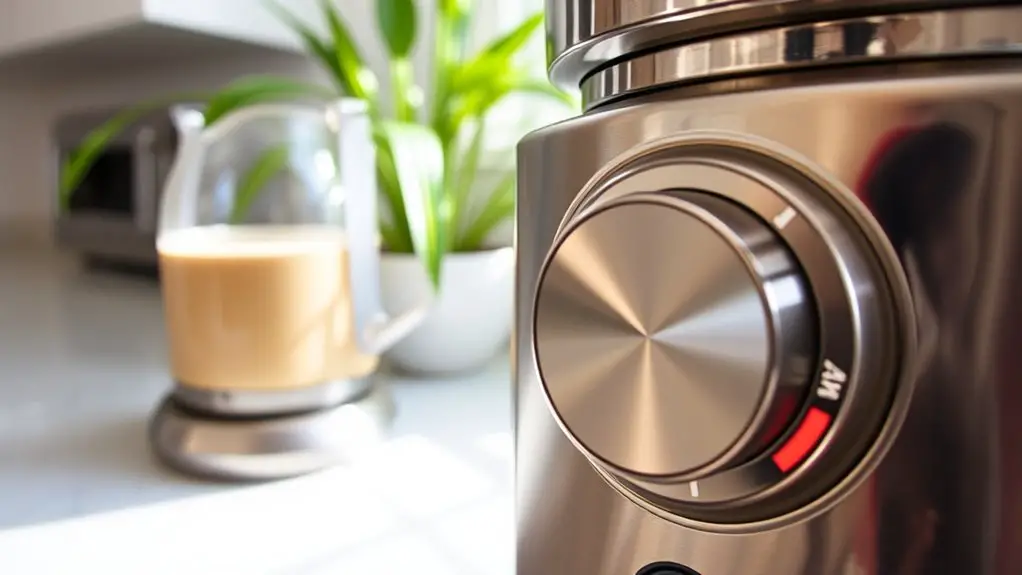If your Cuisinart Grind & Brew is producing weak coffee, it's likely due to the grind size being too coarse. Adjust the grind setting to a finer level, ideally around position 5, for balanced extraction. Finer grinds increase surface area, enhancing flavor and strength. Make sure to choose quality coffee beans, as that also impacts taste. Fine-tuning your brew time and water temperature can further improve results. There's more to explore on optimizing your coffee experience.
Understanding the Importance of Grind Size
When it comes to brewing the perfect cup of coffee, grind size plays a vital role in determining flavor and extraction. The right grind consistency can dramatically affect how your coffee tastes. Finer grinds increase surface area, leading to quicker extraction, which is important for full-bodied flavors. Conversely, coarser grinds slow down extraction, often resulting in a milder taste. Achieving the ideal balance is essential; too fine can make your coffee bitter, while too coarse can leave it weak and underwhelming. Understanding these nuances allows you to tailor your brew to your preferences, enhancing your overall coffee experience. So, pay attention to grind size—it's the key to revealing the rich flavors and aromas that a well-brewed cup can offer. Additionally, setting your grind size to position 5 is often recommended for balanced extraction.
Adjusting the Grind Settings on Your Cuisinart
To achieve the perfect brew, adjusting the grind settings on your Cuisinart can make a significant difference in flavor and aroma. Start by making grind coarseness adjustments based on your brewing method; finer grinds work well for espresso, while coarser grinds suit French press. Familiarize yourself with burr grinder differences—burr grinders provide consistent particle size, enhancing extraction, unlike blade grinders that can produce uneven grinds. Experiment with the dial on your Cuisinart to find the ideal setting for your taste preferences. Don't hesitate to make small tweaks; even slight adjustments can lead to a richer, more robust cup. Remember, the right grind setting reveals the full potential of your coffee, granting you the freedom to enjoy your perfect brew. Additionally, aiming for a medium grind will help avoid clogging and over-extraction in your brewing process.
Choosing the Right Coffee Beans for Stronger Brew
Selecting the right coffee beans is essential for crafting a stronger brew that aligns with your taste preferences. Dark roast beans are often your best bet for a bold flavor and a full-bodied cup. Their longer roasting time intensifies the oils and enhances the richness, giving you that powerful taste you crave. Additionally, exploring various coffee blends can elevate your experience. Blends typically combine different beans, allowing you to enjoy complexity in flavor while maintaining strength. Look for blends that highlight strong chocolate or nutty notes, as these can complement the robustness of dark roasts. By carefully choosing your coffee beans, you facilitate your brewing process and guarantee each cup is a satisfying, invigorating experience. Furthermore, selecting high-quality beans ensures a richer taste and enhances the longevity of your machine.
Experimenting With Brew Time and Water Temperature
While you might think that coffee brewing is a straightforward process, experimenting with brew time and water temperature can greatly influence the final taste of your cup. Adjusting these variables allows you to reveal a spectrum of flavors.
- Brew Time: A longer brew time can extract more oils and flavors, but too long might lead to bitterness.
- Water Temperature: Ideal water temperature ranges from 195°F to 205°F; too hot can scorch your beans, while too cool may under-extract.
- Taste Testing: Don't hesitate to brew multiple cups at varying times and temperatures to find your sweet spot.
Cleaning and Maintaining Your Grinder for Optimal Performance
Maintaining your grinder is essential for ensuring that you consistently achieve the best flavor from your coffee beans. Regular grinder maintenance not only enhances coffee freshness but also preserves the machine's longevity. Here's a quick guide on what you should focus on:
| Task | Frequency |
|---|---|
| Empty the grinder | After every use |
| Clean burrs/blades | Weekly |
| Check for clogs | Monthly |
| Inspect for wear | Every 6 months |
Additionally, regular cleaning helps prevent clogs and maintain performance for optimal grinding results.
Frequently Asked Questions
Can I Use Pre-Ground Coffee in the Cuisinart Grind & Brew?
If you're considering using pre-ground coffee in your Cuisinart Grind & Brew, you can certainly do so. Just remember, adjusting the grind settings might enhance your brew's flavor and aroma, making your experience richer.
What Type of Water Should I Use for Brewing Coffee?
For brewing coffee, you should use filtered water to reduce impurities and chlorine. Ideally, it should have balanced mineral content, enhancing flavors without overpowering them, allowing your coffee to achieve its full potential.
How Does Coffee Freshness Affect Brew Strength?
Coffee freshness greatly impacts brew strength. When beans are fresh, they release ideal flavors and oils, enhancing extraction. Stale beans produce weak coffee, lacking richness. Prioritize fresh beans to elevate your brewing experience and achieve robust flavors.
Is It Safe to Leave Coffee in the Carafe?
Leaving coffee in the carafe isn't recommended for safety or flavor. Prolonged storage can lead to bitterness and bacterial growth. It's best to transfer coffee to an insulated container for ideal taste and carafe safety.
Can I Adjust the Brew Strength on the Cuisinart Grind & Brew?
You can absolutely adjust the brew strength on your Cuisinart Grind & Brew! Tinker with grind settings to release a bolder flavor, maximizing your coffee experience. Embrace the freedom of customization for coffee perfection!
